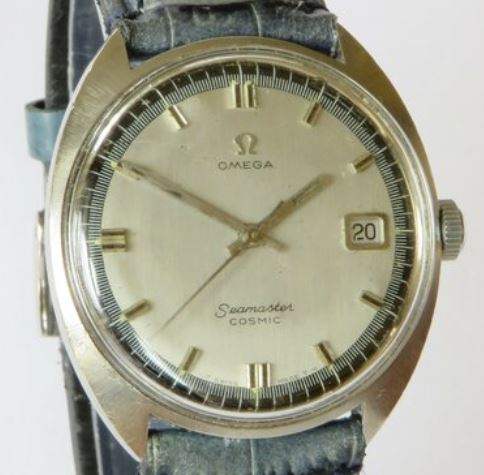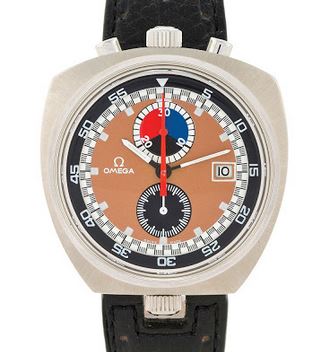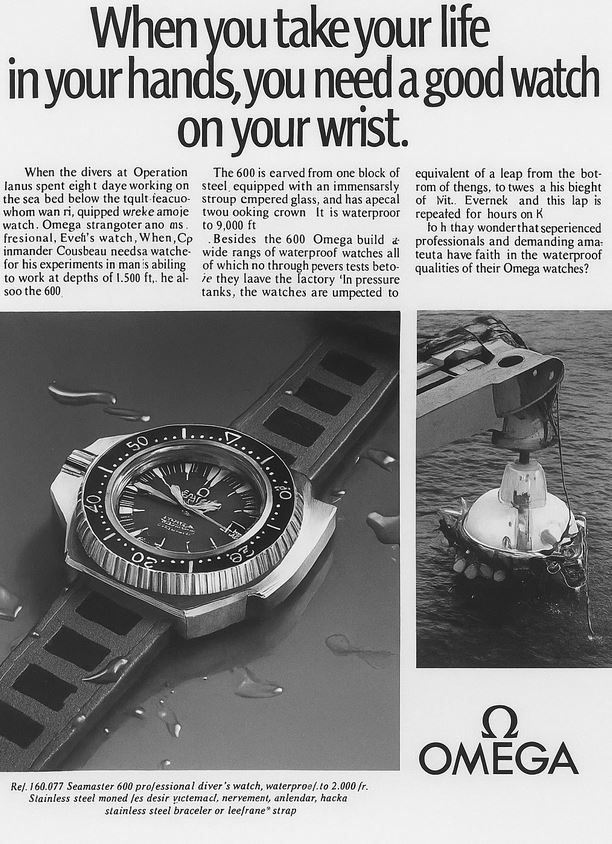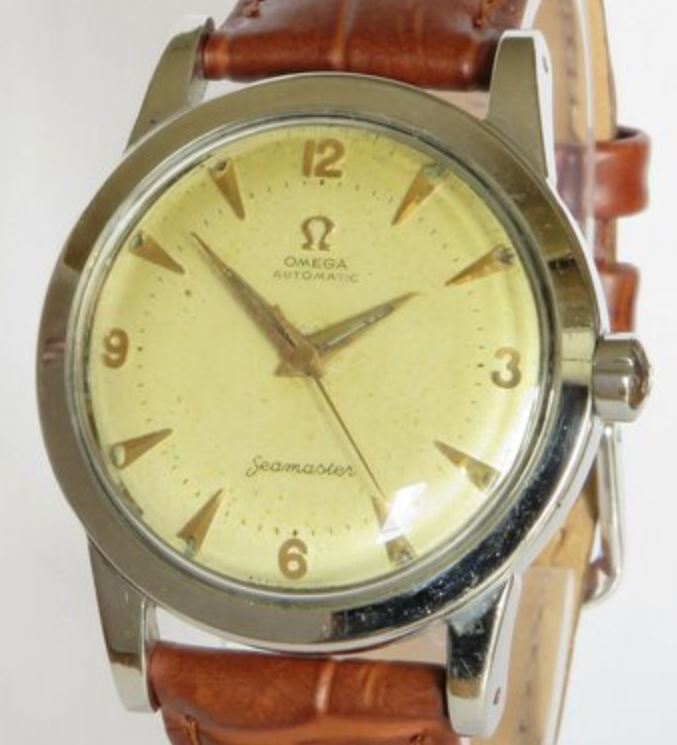Vintage Omega Seamaster watches are renowned for their timeless, understated designs. Featuring clean dials, slim hands, and well-proportioned cases, they reflect the elegance of mid-20th-century watchmaking. Built with durability in mind, these watches were crafted to endure, thanks to high-quality materials and Omega’s advanced waterproofing technology. Many vintage Seamasters remain functional after decades of use, which is proof of their robust construction. Collectors value their longevity, knowing these timepieces can still be worn daily, even after more than half a century. Vintage Omega Seamasters have become a favourite of mine in recent times.
Omega history
Founded in 1848 by Louis Brandt in La Chaux-de-Fonds, Switzerland, Omega operated as a comptoir d’établissage, or an assembly workshop. After Brandt’s death in 1879, his sons Louis-Paul and César took over and moved the business to Biel/Bienne in 1880, where Omega’s headquarters remain today. In 1885, they created their first mass-produced calibre, the Labrador, followed by the first minute-repeater in 1892. In 1894, they developed the 19-ligne calibre, named “Omega,” a Greek term meaning “final part,” which became very popular. The company adopted the Omega name in 1903 and officially became Omega SA in 1982.
During WWI, Omega watches were official timepieces for the Royal Flying Corps and the US Army. In WWII, Omega was chosen by the British Ministry of Defence to produce military watches later known as the “Dirty Dozen“. In 1948, Omega launched the Seamaster, a now iconic model. NASA selected Omega watches for its Apollo missions, including Apollo 11’s 1969 Moon landing. The Speedmaster, used on these missions, remains Omega’s most famous timepiece. Today, Omega is part of the Swiss Swatch Group, recently gaining attention with the Swatch collaboration on the MoonSwatch (Omega at Watch Wiki).
Omega Seamaster
Introduced in 1948 for Omega’s centenary, the Seamaster is Omega’s longest-running model and was instantly popular. Initially, Omega introduced the Seamaster as a gentleman’s water-resistant, dress-style watch. Its design was inspired by waterproof watches made for the Royal Navy during WWII. The Seamaster’s use of an O-ring gasket provided protection against temperature changes and water pressure. In 1955, the Swiss Laboratory for Watch Research successfully tested 50 Seamaster cases to depths of 60 metres. To prove durability, Omega strapped a Seamaster to a plane in 1956 and flew it over the North Pole. The original Seamaster was water-resistant up to 60 metres and Omega marketed it as a versatile, waterproof dress watch. While not specifically designed for professional divers, it was far more robust than a typical dress watch, more than capable of withstanding a day at the beach (Creation of the Seamaster at Omega).
Initially developed for British military divers, the Seamaster evolved into a sophisticated accessory worn by figures like the fictional British Secret Service agent, James Bond. Over 70 years, it has become the most diverse range in Omega’s lineup, featuring dress watches and functional tool watches alike. Its robust design has made it a favourite for divers and military personnel, solidifying its reputation as both a luxury and a practical timepiece.
1948 Omega Seamaster bumper movements
The first generation of Omega Seamaster watches, introduced in 1948, used the calibre 28.10 bumper movement family. In 1949, Omega moved over to the 3-digit calibre reference, the 330 and 340 (sub seconds) and the 350 (sweep seconds) calibres (Omega calibres at Ranfft). Typically, these calibres included 17 jewels, a 42-hour power reserve (the length of time that the watch will run from fully wound to stopped if untouched) and a frequency of 19,800 VPH.
The term “bumper” refers to the automatic winding rotors in these watches. Two small buffer springs cushion the rotor as it moves back and forth. The wearer can actually feel the rotor striking the springs and bouncing back. Hence the name “bumper.”
The Omega 28.10RA has a production period from 1943 to 1949, and is from the 28.10 and 30.10 family, which produced over 1,300,000 units from 1943 to 1955. In 1949, the 28.10RA was renamed to 340. The movement features an automatic (bumper) mechanism and a sub-second function.

The Omega 28.10RASC watch movement, part of the 28.10 and 30.10 families, was in production from 1943 to 1955, producing over 1.3 million units. In 1949, it was rebranded from the 28.10RA SC PC to 350. The movement features automatic (bumper) winding and a sweep second function (Omega movements at EmmyWatch).
Omega Trilogy 1957
In 1957, Omega introduced three professional timepieces that would later achieve iconic status. These were the Seamaster 300 CK 2913, designed with waterproof capabilities for divers; the Railmaster CK 2914, featuring anti-magnetic properties tailored for engineers; and the Speedmaster CK 2915, equipped with a stopwatch function ideal for motorsports. The Seamaster 300 significantly enhanced the water resistance of its dressier predecessor to 200 metres (Omega 1957 Trilogy at Worn & Wound).
Omega Seamaster 300
Omega released the Seamaster 300 in 1957, designing it as a professional diving watch with advanced functionality. It marked a significant evolution in the Seamaster line, combining durability, precision, and water resistance for demanding underwater environments.
This model featured a stainless steel case with a unidirectional rotating bezel, aiding divers in tracking dive times. Its water resistance rated to 200 meters, but Omega confidently named it the Seamaster 300, implying it could withstand even greater depths. The watch’s robust design reflected Omega’s commitment to catering to professionals in extreme conditions.
The Seamaster 300 introduced a clear, highly legible dial layout. Large, luminous markers and broad hands ensured visibility in low-light underwater conditions. The “broad arrow” hour hand, in particular, became an iconic feature of this model. It also used Omega’s calibre 501, a reliable automatic movement that underscored its precision and performance.
The Omega Seamaster Cosmic
The Omega Seamaster Cosmic was a strategic offshoot of the classic Seamaster collection, produced from 1966 to 1980. It was created to attract a younger, more style-conscious audience with its accessible price and modern design. The name “Cosmic” was a deliberate marketing choice, intended to capitalise on Omega’s association with the space race and the Speedmaster “Moonwatch”.

Monocoque case design and calibres
The early Seamaster Cosmic models featured an innovative monocoque, or single-piece, case. This design, which could only be accessed from the front, enhanced water resistance. However, it also made servicing the watch more difficult and costly. In 1972, Omega introduced the Seamaster Cosmic 2000, which featured an improved two-piece “case within a case” design. This new design simplified repairs and doubled the watch’s water resistance from 30 metres to 60 metres.
A reliable range of Omega calibres powered the Cosmic series. Early models used manual-wind movements like the Calibre 601, while later models featured automatic movements such as the Calibre 562, which was often certified as a chronometer. The later Cosmic 2000 generation introduced higher-frequency automatic movements like the Calibre 1012 and Calibre 1022 (Omega calibres at EmmyWatch).
The end of the Cosmic
The “Quartz Crisis” of the 1970s began the downfall of the Seamaster cosmic. This industry-wide disruption forced Omega to restructure and streamline its product lines, focusing on its most profitable models, the Speedmaster and the Seamaster. Today, the Omega Seamaster Cosmic is a uniquely affordable collector’s item, despite the challenges associated with servicing its complex case.
Omega calibre 501
The 1957 Omega Seamaster 300 used the self-winding calibre 501. Known for its exceptional quality, this top-tier movement is regarded as one of the finest mass-produced automatics of its time. The copper-coloured Calibre 501 features 20 jewels, a straight-line lever escapement, a monometallic balance, and an Incabloc shock protection system. It also includes a self-compensating flat balance spring and a micrometer regulator, allowing precise adjustments. The movement measures 12.5 ‴ lignes (28 mm) in diameter and offers an impressive power reserve of 46 hours (Omega 501 at WatchBase).

Omega produced the calibre 501 between 1955 and 1960, during which it earned a reputation for accuracy and reliability. Notably, it was Omega’s first full rotor-driven movement, a significant advancement that contributed to its enduring prestige. Previously, Omega’s self-winding calibres utilised the bumper system, featuring an oscillating weight that rocked back and forth within a limited arc. However, in 1955, Omega decided to transition to the more conventional rotor-based design, a system traditionally associated with Rolex. This marked the beginning of the gradual phase-out of the bumper movement in favour of the more efficient and durable rotor mechanism.
The Omega Seamaster 600
Omega introduced the Seamaster 600-series in 1964 and production continued to 1969. The SM600 proved to be a successful product for Omega and they sold in significant quantities. It considered an entry level Seamaster, a rich man’s Genève, so was slightly less expensive than higher ranges. The name “600” is a reference to the range of manual-wind Omega calibres used: 601, 611 (date) and 613 (quickset date). The SM600 still very much fit the mould of the original Seamaster’s, it was designed for “town, sea and country”. In other words, a water resistant gentlemen’s dress watch. It was suitable office attire during the week and perfect for the beach at the weekend.
The SM600 came in two case sizes, 34.5mm and 32.5mm. These case sizes were typical for a 1960s men’s dress watch. The specific case references are:
Calibre 601: 135.011 (34.5mm) and 135.012 (32.5mm), lug width 18mm.
Calibres 611 & 613: 136.011 (34.5mm) and 136.012 (32.5mm), lug width 18mm.
Cases were either plain stainless steel or plated in rose or yellow gold. Typically, the SM600 the case back featured the engraved Seamaster logo. However, there were some with a plain case back, which may have been intentional to allow for engraving.
The case design of the SM600 was very simple, which means the watch is all about the dial. The
text on the dial varies depending on production years. Initially, it started with “Seamaster 600” (1964-1966), then “Seamaster 600 Genève” (1967-1968) and finally “Genève”(1968-1969) with the Seamaster 600 text omitted from the dial. There was a huge range of dials, including black military style dials along with white, silvered, champagne, grey and textured dials.
Omega Seamaster Bullhead
Omega launched the Seamaster Bullhead in 1969 as part of its Chronostop collection. It is a bizarre-looking watch. Designed as a driver’s or rally watch, it earned the nickname “Bullhead” due to its distinctive layout. The winding crown is positioned at 12 o’clock with chronograph pushers on either side, resembling a bull’s head.

The Bullhead housed the calibre 930 movement, which was also used in some De Ville models. It featured a twin-register chronograph with a date display and was offered in both stainless steel and gold-plated versions. The manually wound calibre 930 was an evolution of Omega’s 27 CHRO movement, enhanced with a date function. When first released in 1969, the Bullhead was considered an innovative design, though it failed to achieve widespread popularity. Most buyers preferred the more conventional and purpose-built Speedmaster Professional, which offered similar mechanics in a more refined package.
Decades later, however, collectors began to appreciate the Bullhead’s unusual charm and bold design, sparking renewed interest in the model. Recognising this, Omega reissued the Seamaster Bullhead in 2013 with an automatic movement. They produced three limited-edition versions of 669 pieces each. A fourth special edition followed in 2016 to celebrate the Rio Olympic Games, limited to 316 pieces.
Omega Seamaster 600 Ploprof
The Omega Seamaster Ploprof 600 was conceived in the late 1960s as a purpose-built, ultra-robust dive watch. The odd name, Ploprof came from the French “plongeur professionnel”, or “professional diver”. The watch was engineered as a critical piece of survival equipment for professional saturation divers. It was developed in cooperation with groups like COMEX, who used the watch during projects such as Operation Janus. The Seamaster Ploprof was first advertised in February 1971, yet production did not fully commence until late that year, and the earliest batch was completed by early 1972 (11 remarkable omega ads from the past at Fratello).

The Ploprof had a highly distinctive large, asymmetrical monobloc case with a locking bezel mechanism operated via a red push-button, and a crown positioned at 9 o’clock. The watch achieved 600 m water resistance in its official rating. For movement, early prototypes used the Omega Calibre 1000, but the production retail version used the automatic Calibre 1002 (a high-frequency movement with instant date change). Over its lifetime, the Ploprof saw a number of variants: different dials (including one with a rare blue overprint), multiple bezels, hands, and case versions. Production continued with a number of variations until the late 1970s (Omega Seamaster Ploprof 600 at WatchProSite). Despite its odd looks, it was popular with professional divers of the period and retains a cult follwoing with collectors.
The Naiad winding crown
Early Omega Seamasters used an in-house self-sealing winding crown to improve water resistance. The Omega Naiad winding crown, introduced around 1937, used a spring-loaded gasket system to enhance water resistance. The nymphs in Greek mythology who lived in lakes, rivers, springs, and fountains inspired the Naiad name. Unlike screw-down crowns, the Naiad crown featured a spring-loaded gasket system that compresses more tightly as water pressure increases. This offered convenience and improved performance. However, in shallow water, the pressure was insufficient to make a good seal at times and could result in leaking. The Naiad crown was first used in the Naiad and Medicus Naiad ranges in 1937. It later appeared in Seamaster and Constellation models, but its reliability depended on gasket condition and spring precision (Omega Seamaster at Chronopedia).
Omega discontinued the Naiad winding crown in the early to mid-1960s, favouring screw-down crowns for their durability and suitability for professional dive watches. The Naiad name now persists in Omega’s modern Naiad Lock system for aligning case back engravings. The Naiad winding crown had a small cross in the centre of the Ω symbol.
Hippocampus logo
Early Seamasters featured a blank case back. However, around 1955, the Seamaster name began to appear. The iconic Hippocampus logo on the case backs of Omega Seamaster watches was introduced in 1958. It was created by Italian engraver Jean-Pierre Borle, who worked with Omega to design a symbol reflecting the brand’s maritime heritage. The Hippocampus, a mythical sea creature with the head of a horse and the tail of a fish, symbolises the watch’s strong connection to the sea. According to legend, it is said that Poseidon, the god of the sea, drove a chariot drawn by a hippocampus.

Omega chose this emblem to emphasise the Seamaster’s water resistance and suitability for aquatic environments. It also aligned with the line’s reputation as a professional diver’s watch. Borle drew inspiration for the logo from traditional designs found on Venice gondolas, which often featured similar sea creatures. The engraving became a lasting feature of Seamaster watches, representing durability, adventure, and the elegance of the ocean (Omega Seahorse Logo at SwissWatchExpo).
Early Seamaster variations
Early Omega Seamaster watches were supplied in a couple of variants. First, there was the option of hand-winding or self-winding automatic movements. Secondly, there was a choice between sub-seconds or central seconds on the dial. Both of these options were made available due to consumer preferences at the time. I must admit, I prefer the automatic option, but I wasn’t around in the 1950s.
When the Seamaster was introduced in 1948, automatic movements were still relatively new and more expensive to produce and service. In contrast, hand-wound movements were simpler, more rugged and cost-effective, making them an accessible choice for customers who wanted a durable, Swiss-made watch. During the 1940s and 1950s, many buyers were used to manual-wind watches, so there was less demand for automatics. Omega catered to both preferences by producing hand-wound and automatic Seamaster models.
Sub-seconds (small seconds positioned in a separate sub-dial) were also a consumer preference in early Seamaster models. They were common in wristwatch movements during the first half of the 20th century. Many early Seamaster watches used existing hand-wound calibres from Omega’s backlist, such as the calibre 30 series, which featured sub-seconds as part of their design. Sub-seconds were considered a classic and elegant design choice at the time. They appealed to those who preferred a traditional look rather than the more modern central seconds. As automatic movements with improved designs became more acceptable to the watch-buying public, central seconds became more popular (Omega Seamaster history at Chronopedia).
As watchmaking evolved and automatic movements became more refined and affordable, Omega shifted its Seamaster lineup to include more automatics with central seconds, reflecting changing technology and market preferences. Hand-winding movements and sub-seconds dials had largely disappeared from the Seamaster range in the late 1960s as consumer preferences changed.
Investment Value
Vintage Omega Seamaster watches have grown increasingly collectable, with their value steadily appreciating over recent years. Collectors prize models in excellent condition, with original components and distinctive features like patina dials or rare movements. As interest in vintage luxury watches rises, a vintage Seamaster offers visual appeal from a classic design and promising investment potential.
There are tax benefits for vintage watch collectors in the UK because the HMRC considers them “wasting assets”. According to HMRC, vintage clocks and watches, such as vintage Omega Seamasters, are regarded as machinery. As a result, they are deemed to have a predictable life of only fifty years and are treated as wasting assets. The disposal of such an asset will only give rise to a chargeable gain if it had been used for business purposes and Capital Allowances were or could have been claimed. Therefore, as long as you are not actively trading vintage watches, any profit is considered capital gains tax-free if the watch is at least 50 years old. As with all things tax-related, seek specific financial advice before selling your vintage watch collection. After all, rules can change, and you don’t want to be on the wrong side of HMRC.
Conclusion
The Omega Seamaster is a watch that has endured the test of time. With its classic design, innovative technology, and rich history, the Seamaster remains one of the most beloved and sought-after timepieces available. Omega Seamaster models of the 1940s and ‘50s, along with the Rolex Oysters of the same period, were the forerunners of the modern-day sports watch as we know it now. Whether you’re a collector, an investor, or simply a fan of fine watches, a vintage Omega Seamaster is a watch that is sure to capture your attention and leave a lasting impression.
It has been enjoyable researching and writing this article. I can see a few more Seamasters passing through my collection. No doubt, I will add to this post on the history of the Omega Seamaster. If I have missed anything or there are any specific requests, please add them to the comments below.


Leave a Reply